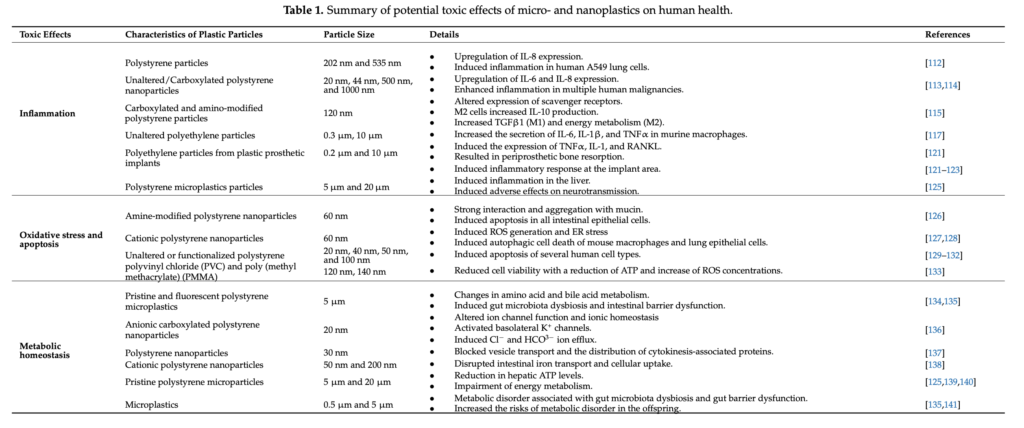This is an explanation of the toxic effects micro- and nanoplastics can have on human health, as published in:
Impact of Microplastics and Nanoplastics on Human Health
Published In: Nanomaterials
On: Feb 11, 2021
Table 1 of this review paper, referencing 28 different sources, summarizes the potential effects plastic particles can have on our health.

Access this table on page 12 of the online article.
Key Takeaways
This table provides a basic understanding of the potential health impacts of micro- and nanoplastics, focusing on inflammation, oxidative stress, apoptosis, and metabolic homeostasis, and how these are influenced by the characteristics and sizes of the plastic particles.
The table shows that research studies have documented the toxic effects plastic particles can have on animal cells and human cells. The known short-term impacts include inflammation, cell damage, and metabolic disruption in cells. Many of these studies have been conducted in vitro (cell cultures outside of the body) or in mice.
Inflammation
- Characteristics of Plastic Particles: Various types of polystyrene and polyethylene particles, including those unaltered, carboxylated, amino-modified, and from prosthetic implants, can cause inflammation.
- Particle Sizes: Range from 1,000 nm to 0.2 µm.
- Key Points:
- Inflammation is the body’s response to injury or infection, often causing redness, heat, swelling, and pain.
- These plastic particles can increase inflammatory markers like IL-6, IL-8, TNFα, and others, leading to inflammation in different parts of the body including lungs, liver, and around prosthetic implants.
Oxidative Stress and Apoptosis
- Characteristics of Plastic Particles: Various modified and unmodified polystyrene particles can induce oxidative stress and apoptosis in different human cells.
- Particle Sizes: Range from 140 nm to 20 nm.
- Key Points:
- Oxidative stress occurs when there’s an imbalance between free radicals and antioxidants, damaging cells.
- Apoptosis is a process where cells program themselves to die. These plastic particles can trigger this process in cells, affecting their survival and health.
Metabolic Homeostasis
- Characteristics of Plastic Particles: Different polystyrene and polyethylene particles can disrupt metabolic homeostasis.
- Particle Sizes: Range from 200 nm to 0.5 µm.
- Key Points:
- Metabolic homeostasis refers to the balance of chemical reactions in the body. Disruption can lead to metabolic disorders.
- The particles can cause changes in metabolism, affecting gut microbiota, ion channel function, cellular energy levels, and nutrient transport, which might lead to metabolic disorders.
